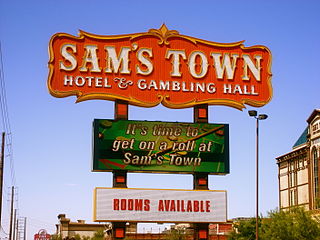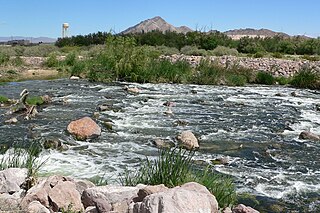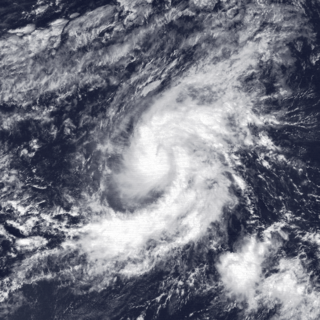Related Research Articles

The Las Vegas Valley is a major metropolitan area in the southern part of the U.S. state of Nevada, and the second largest in the Southwestern United States. The state's largest urban agglomeration, the Las Vegas Metropolitan Statistical Area is coextensive since 2003 with Clark County, Nevada. The Valley is largely defined by the Las Vegas Valley landform, a 600 sq mi (1,600 km2) basin area surrounded by mountains to the north, south, east and west of the metropolitan area. The Valley is home to the three largest incorporated cities in Nevada: Las Vegas, Henderson and North Las Vegas. Eleven unincorporated towns governed by the Clark County government are part of the Las Vegas Township and constitute the largest community in the state of Nevada.

Bellagio is a resort, luxury hotel and casino on the Las Vegas Strip in Paradise, Nevada. It is owned by The Blackstone Group and operated by MGM Resorts International. Bellagio was conceived by casino owner Steve Wynn, and was built on the former site of the Dunes hotel-casino. Wynn's company, Mirage Resorts, purchased the Dunes in 1992. Plans were announced in 1994 to replace it with Beau Rivage, a French-themed resort. However, Wynn changed the project plans in 1995, instead theming it after the village of Bellagio, near Lake Como. The resort was designed by Jon Jerde. Construction began on November 1, 1995, with Marnell Corrao Associates as general contractor.

The Boardwalk Hotel and Casino was a Coney Island-style hotel on the Las Vegas Strip. The property began in 1966, as a Holiday Inn. Norbert Jansen added a gift shop to the hotel in 1972, and later opened the Slot Joynt casino. In 1985, Jansen renamed the Holiday Inn as the Viscount Hotel, part of a U.S. chain. Four years later, he merged Slot Joynt with the Viscount and renamed them as the Boardwalk. It rejoined the Holiday Inn chain in 1994, through a franchise deal which eventually ended in 2002.

Mandalay Bay is a 43-story luxury resort and casino at the south end of the Las Vegas Strip in Paradise, Nevada. It is owned by Vici Properties and operated by MGM Resorts International. It was developed by Circus Circus Enterprises and completed at a cost of $950 million. It opened on March 2, 1999, on the former site of the Hacienda hotel-casino. MGM acquired Mandalay Bay in 2005, and Blackstone became a co-owner in 2020. Vici acquired MGM's ownership stake in 2022.

Sam's Town Las Vegas is a hotel and casino located in Sunrise Manor, Nevada on the corner of Flamingo Road and Boulder Highway. It is one of the casinos owned and operated by Boyd Gaming. It features a 25,000-square-foot indoor park, bowling center, movie theater, and one of the largest casino floors in Las Vegas.
Station Casinos, LLC is an American hotel and casino company based in Las Vegas suburb of Summerlin South, Nevada, and founded by Frank Fertitta Jr. Station Casinos, along with Affinity Gaming, Boyd Gaming and Golden Entertainment, dominate the locals casino market in Las Vegas. The company purchased several sites that were gaming-entitled, meaning that major casinos can be built at that location without additional approvals. There are only a limited number of such sites available in the Las Vegas area. Station Casinos has also branched out into managing casinos that they do not own. Red Rock Resorts, Inc. is a publicly traded holding company that owns a portion of Station Casinos.

The Linq is a casino hotel on the Las Vegas Strip in Paradise, Nevada. It is owned and operated by Caesars Entertainment. It opened as the Flamingo Capri in 1959, on property located directly north of the original Flamingo resort. The Flamingo Capri was a 180-room motel, owned by George E. Goldberg and Flamingo employee Bill Capri.
The Clark County Regional Flood Control District (CCRFCD) was created in 1985 by the Nevada Legislature allowing Clark County to provide broad solutions to flooding problems. The District has developed plans and so far successfully continued working on a 50-year program to eliminate most flooding from a 100-year flood in the populated areas for which the CCRFCD is responsible.

The Rio is a hotel and casino near the Las Vegas Strip in Paradise, Nevada, United States. It is owned by Dreamscape Companies LLC and operated by Caesars Entertainment. It includes a 117,330 sq ft (10,900 m2) casino and 2,520 suites. It features a Brazilian theme based on Rio Carnival.

Lake Las Vegas in Henderson, Nevada, refers to a 320-acre (130 ha) reservoir and the 3,592-acre (1,454 ha) developed area around the reservoir. The area is sometimes referred to as the Lake Las Vegas Resort. It is being developed by 5 companies including Lake at Las Vegas Joint Venture LLC.
JW Marriott Las Vegas Resort and Spa is a resort in Summerlin, Nevada, near Las Vegas. The Rampart Casino is located within the hotel. The property is owned and operated by Hotspur Resorts, which franchises the JW Marriott name from Marriott International. The hotel has 548 rooms and the casino measures 57,610 square feet (5,352 m2).

Las Vegas Wash is a 12-mile-long channel which feeds most of the Las Vegas Valley's excess water into Lake Mead. The wash is sometimes called an urban river, and it exists in its present capacity because of an urban population. The wash also works in a systemic conjunction with the pre-existing wetlands that formed the oasis of the Las Vegas Valley. The wash is fed by urban runoff, shallow ground water, reclaimed water used on parks and golf courses, and stormwater.

Texas Station was a casino hotel in North Las Vegas, Nevada. It was owned and operated by Station Casinos. Texas native Frank Fertitta Jr., the hotel-casino's original owner, chose the Texas theme to appeal to customers from his home state. Fertitta sold the hotel-casino for $95 million to Station Casinos, his former company, prior to its opening on July 12, 1995. It was the largest hotel-casino in North Las Vegas at the time of its opening, with a 60,000 sq ft (5,600 m2) casino and a 200-room hotel.

Tropical Storm Octave was considered the worst tropical cyclone in the history of Arizona. The nineteenth tropical cyclone and fifteenth named storm of the 1983 Pacific hurricane season, the origins of Tropical Storm Octave were from a tropical disturbance that formed south of the Gulf of Tehuantepec on September 23, 1983. Steered by a deep layer high over Mexico, the disturbance moved west for four days before becoming a tropical depression on September 27 off the southwest coast of Mexico. Over an area of warm sea surface temperatures, it was able to quickly strengthen to peak winds of 50 mph (85 km/h), through wind shear prevented much further development. By September 30, Octave was accelerating to the northeast, steadily weakening due to cooler waters. That day it weakened to tropical depression status, and on October 2, Octave dissipated.

Fiesta Rancho was a hotel and casino located on 25.46 acres (10.30 ha) of land at 2400 North Rancho Drive in North Las Vegas, Nevada, across the street from the Texas Station hotel and casino. The Maloof family opened the Fiesta on December 14, 1994, with 100 rooms and a 25,000 sq ft (2,300 m2) casino. It was the first hotel-casino to open in North Las Vegas.
Key Largo was a hotel and casino located on 4.85 acres (1.96 ha) of land at 377 East Flamingo Road, one mile east of the Las Vegas Strip, in Paradise, Nevada.

Rhodes Ranch is a master-planned community and golf course located in Spring Valley, Nevada, approximately six miles southwest of the Las Vegas Strip. It was developed by Jim Rhodes. The community was announced in 1996, after Rhodes gained 1,330 acres, some of it through the Bureau of Land Management. At the time, much of the surrounding area was rural, and nearby residents opposed the development of the land. Despite the opposition, the Rhodes Ranch project was approved and began construction.

The Water Street District is a redeveloped portion of downtown Henderson, Nevada. It includes stores, restaurants, and office and residential space. It also hosts numerous annual events, including festivals, parades, car shows, and a farmers' market. The area is also home to Henderson's city hall and justice facility.
Severe floods occurred in western and northern Nevada from January 1-3, 1997, resulting in two deaths and causing $450 million in building damage. Washoe County, which includes the Reno-Sparks area, saw the worst of the damage. Flooding also impacted five other counties, as well as Carson City.
References
- ↑ "Southern Nevada prepares for two months of storms". Las Vegas Sun. July 8, 1999. Retrieved January 3, 2023.
- 1 2 3 4 5 Hansen, Kyle B. (July 8, 2009). "A decade after deadly flood, county better prepared". Las Vegas Sun. Retrieved January 1, 2023.
- ↑ "Flood of July 8,1999, in Las Vegas Valley, southern Nevada" (PDF). United States Geological Survey. July 2000. Retrieved January 1, 2023.
- 1 2 "Flood control still a work in progress". Las Vegas Sun. July 26, 1999. Retrieved January 3, 2023.
- ↑ Hawley, Tom (August 5, 2021). "Las Vegas has history with deadly and dangerous flash flooding". KSNV. Retrieved January 1, 2023.
- 1 2 3 4 "Water, Water — But Not Everywhere". Nevada Public Radio. August 1, 2019. Retrieved January 3, 2023.
- 1 2 3 4 "An Analysis of the July 8, 1999 Las Vegas Valley Flash Flood Event Using the Weather Event Simulator (WES)" (PDF). National Weather Service. Retrieved January 1, 2023.
- 1 2 3 "Vegas Cleans Up After Storm". CBS. July 8, 1999. Retrieved January 1, 2023.
- 1 2 Wagner, Angie (July 8, 1999). "Rains flood Vegas, swallow cars, smash homes, knock down walls". Las Vegas Sun. Retrieved January 3, 2023.
- 1 2 3 4 5 6 7 8 9 Schoenmann, Joe (July 9, 1999). "100-Year Storm". Las Vegas Review-Journal. Archived from the original on October 8, 1999.
- ↑ Papa, Paul W. (2009). It Happened in Las Vegas: Remarkable Events that Shaped History. Rowman & Littlefield. pp. 121–125. ISBN 978-0-7627-5819-7 . Retrieved January 6, 2023.
- ↑ Lupiani, Joyce (July 8, 2019). "July 8th is 20-year anniversary of 100-year flood in Las Vegas". KTNV. Retrieved January 1, 2023.
- 1 2 3 Gray, Luz (July 12, 2019). "With harrowing virtual reality video, local authorities educate youth on flood dangers". The Nevada Independent. Retrieved January 5, 2023.
- 1 2 3 4 Michor, Max (July 7, 2019). "Looking back at 1999 Las Vegas flood 20 years later". Las Vegas Review-Journal. Retrieved January 4, 2023.
- ↑ "Question of the Day". Las Vegas Advisor. February 16, 2017. Retrieved January 1, 2023.
- 1 2 3 4 Macy, Robert (July 9, 1999). "$400 million flood control project saves lives, property". Las Vegas Sun. Retrieved January 3, 2023.
- ↑ "Flood basins, filled to brim, protect property". Las Vegas Sun. July 9, 1999. Retrieved January 3, 2023.
- ↑ Zapler, Mike (July 11, 1999). "Flood control measures avert worse damage". Las Vegas Review-Journal. Archived from the original on October 12, 1999.
- ↑ "Officials say flood-control system worked". Las Vegas Sun. August 13, 1999. Retrieved January 4, 2023.
- ↑ Russell, Kiley (July 14, 1999). "Minor flooding hits valley, damage assessment efforts continue". Las Vegas Sun. Retrieved January 3, 2023.
- ↑ "Clinton to make call on flood aid". Las Vegas Sun. July 19, 1999. Retrieved January 3, 2023.
- 1 2 3 Padgett, Sonya (July 12, 1999). "Financial wash: Thursday's flood wipes out insuranceless homeowners". Las Vegas Sun. Retrieved January 3, 2023.
- 1 2 Lake, Richard (July 21, 2002). "Flood control serious business". Las Vegas Review-Journal. Archived from the original on August 2, 2002.
- ↑ Whaley, Sean (July 28, 1999). "New Flamingo Wash bridges approved for Boulder Highway". Las Vegas Review-Journal. Archived from the original on October 12, 1999.
- ↑ Retrieved January 5, 2023:
- Bach, Lisa Kim; Patton, Natalie (July 9, 1999). "Miracle Mile Mobile Home Park goes from quiet to chaotic". Las Vegas Review-Journal. Archived from the original on October 12, 1999.
- Russell, Kiley (July 9, 1999). "Residents of flooded trailer park begin digging out". Las Vegas Sun.
- Bass, Debra D. (July 10, 1999). "Mobile home residents begin cleanup amid shock of damage". Las Vegas Review-Journal. Archived from the original on October 12, 1999.
- "Miracle Mile flooding may have been averted". Las Vegas Sun. August 6, 1999.
- Morrison, Jane Ann (August 8, 1999). "Lost in a Flash". Las Vegas Review-Journal. Archived from the original on October 13, 1999.
- ↑ Koch, Ed; Radke, Jace (July 9, 1999). "Damage assessed, area braces for more rain". Las Vegas Sun. Retrieved January 6, 2023.
- 1 2 "Rains threaten more flooding". Las Vegas Sun. July 12, 1999. Retrieved January 3, 2023.
- ↑ Berns, Dave (July 10, 1999). "Floods barely make trickle in business at area casinos". Las Vegas Review-Journal. Archived from the original on October 9, 1999.
- 1 2 3 Berns, Dave; Caruso, Monica (July 9, 1999). "Forum Shops, casino pit at Caesars close". Las Vegas Review-Journal. Archived from the original on October 8, 1999.
- ↑ Rogers, Keith (July 9, 1999). "Damage from worst floods parallels growth". Las Vegas Review-Journal. Archived from the original on October 8, 1999.
- ↑ Thompson, Gary (July 12, 1999). "Flooding delays the opening of the Resort at Summerlin". Las Vegas Sun. Retrieved January 5, 2023.
- ↑ Smith, Hubble (July 13, 1999). "Resort opening delayed". Las Vegas Review-Journal. Archived from the original on October 8, 2000.
- ↑ Weatherford, Mike (July 9, 1999). "Shows cannot go on after storm". Las Vegas Review-Journal. Archived from the original on October 8, 1999.
- ↑ White, Ken (July 9, 1999). "TV offers flood of coverage". Las Vegas Review-Journal. Archived from the original on October 8, 1999.
- ↑ Caruso, Monica (July 10, 1999). "Officials quickly counter bad publicity from flood". Las Vegas Review-Journal. Archived from the original on October 12, 1999.
- ↑ Morrison, Jane Ann (July 10, 1999). "LV woman's loss, strength strike Guinn". Las Vegas Review-Journal. Archived from the original on October 12, 1999.
- ↑ Rogers, Keith (July 11, 1999). "Additional storms fail to emerge". Las Vegas Review-Journal. Archived from the original on October 12, 1999.
- ↑ Bass, Debra D. (July 13, 1999). "Flood victims turning to Red Cross for help". Las Vegas Review-Journal. Archived from the original on October 13, 1999.
- ↑ Schoenmann, Joe (July 10, 1999). "Flood damage to cost millions". Las Vegas Review-Journal. Archived from the original on October 9, 1999.
- ↑ Packer, Adrienne; Manning, Mary (July 15, 1999). "County declared state disaster area". Las Vegas Sun. Retrieved January 6, 2023.
- ↑ Friess, Steve (July 16, 1999). "Guinn declares emergency, requests federal aid for flood". Las Vegas Review-Journal. Archived from the original on January 18, 2000.
- 1 2 "Nevadans pleased with federal aid for flood damage". Las Vegas Sun. July 21, 1999. Retrieved January 3, 2023.
- ↑ Schoenmann, Joe; Rogers, Keith (July 21, 1999). "Clinton OKs disaster funds". Las Vegas Review-Journal. Archived from the original on October 13, 1999.
- ↑ "FEMA to open disaster relief center for flood victims". Las Vegas Sun. July 25, 1999. Retrieved January 3, 2023.
- ↑ Friess, Steve (July 30, 1999). "Reservists on watch for disaster". Las Vegas Review-Journal. Archived from the original on October 12, 1999.
- 1 2 "Impact of July 8 flood still felt". Las Vegas Sun. August 17, 1999. Retrieved January 4, 2023.
- ↑ "Flood victims receive first funds from SBA". Las Vegas Sun. August 12, 1999. Retrieved January 4, 2023.
- ↑ "Spencer Street bridge, closed by 1999 flood, is reopened". Las Vegas Sun. June 26, 2002. Retrieved January 5, 2023.
- ↑ Geary, Frank (October 4, 1999). "Flood Abatement Program: County to bolster wash". Las Vegas Review-Journal. Archived from the original on June 28, 2001.
- ↑ "Residents sue county over flood damage from creek". Las Vegas Sun. September 26, 2000. Retrieved January 5, 2023.
- ↑ Johnson, Erica D. (August 21, 2003). "County to pay $1.1 million to homeowners in '99 flood". Las Vegas Sun. Retrieved January 5, 2023.
- ↑ Packer, Adrienne (August 21, 2003). "County to pay homeowners $1.1 million for '99 flood". Las Vegas Review-Journal. Archived from the original on September 22, 2004.
- ↑ Jessie, Faith (July 8, 2019). "Water Always Wins: Officials warn residents of flash floods ahead of monsoon season". KSNV. Retrieved January 1, 2023.